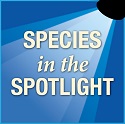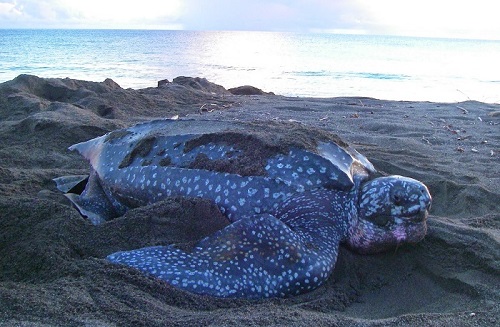 Leatherback sea turtles (Dermochelys coriacea) are globally listed under the ESA as endangered. Like other sea turtle species, leatherbacks face significant threats from entanglement and/or hooking in fisheries (bycatch), directed take (including eggs and adults), coastal development, pollution, marine debris, and climate change. While climate change is an emerging and major threat to marine turtle conservation and recovery, leatherbacks are particularly vulnerable to bycatch in fisheries. Gear modification and best practices have been implemented in many fisheries that have reduced incidental bycatch of leatherbacks, but globally impacts from artisanal and industrial fishing operations have not been resolved. Currently, fishery bycatch remains the most significant threat to leatherbacks.
Leatherback sea turtles (Dermochelys coriacea) are globally listed under the ESA as endangered. Like other sea turtle species, leatherbacks face significant threats from entanglement and/or hooking in fisheries (bycatch), directed take (including eggs and adults), coastal development, pollution, marine debris, and climate change. While climate change is an emerging and major threat to marine turtle conservation and recovery, leatherbacks are particularly vulnerable to bycatch in fisheries. Gear modification and best practices have been implemented in many fisheries that have reduced incidental bycatch of leatherbacks, but globally impacts from artisanal and industrial fishing operations have not been resolved. Currently, fishery bycatch remains the most significant threat to leatherbacks.
Recovery
The U.S. has taken significant steps to protect leatherbacks in its waters. In the Pacific, since 2001 the Pacific Leatherback Conservation Area off of California has prohibited drift gillnet fishing from August 15 to November 15 in 213,000 square miles of the Exclusive Economic Zone. In 2009, the Mariana Trench, Rose Atoll, and Pacific Remote Islands National Monuments (95,000 square miles) were established, prohibiting commercial and recreational fisheries, thus providing important protected areas for leatherbacks. Like the Atlantic fisheries, the Hawaii-based longline fisheries have been regulated to reduce leatherback interactions.

As required by NOAA Fisheries, skippers participating in the Hawaii-based longline fishery and the California drift gillnet fishery must attend Protected Species Workshops annually where they receive new and updated information (including TurtleWatch, a predictive map of where turtles may occur so that fishermen can avoid fishing in those areas), and are trained on safe handling and release procedures, which includes the resuscitation of sea turtles. Longline fishermen are also required to carry and use dipnets, line cutters, and dehookers to release any incidentally caught sea turtles.
The United States has also actively engaged in international efforts to recover Atlantic and Pacific leatherbacks, as U.S. efforts alone will not recover leatherbacks. This includes participation in several multilateral and regional treaties that have resulted in measures to conserve leatherback. Some of the accomplishments under these agreements include the development of the InterAmerican Convention for the Protection and Conservation of Sea Turtles (IAC) East Pacific Leatherback Task Force, which is identifying ways that IAC Parties can implement the 2012 New Plan of Action for East Pacific Leatherbacks.
The United States has also played a leadership role within Regional Fishery Management Organizations, proposing and/or supporting resolutions to protect sea turtles. In addition to these regional and multilateral agreements, NOAA Fisheries and FWS have supported bilateral projects, either through grants or in-kind support to recover Pacific leatherbacks throughout their range. For instance, in Papua Barat, Indonesia, a significant nesting area for Western Pacific leatherbacks, NOAA Fisheries and FWS have collaborated with local institutions for more than a decade to reduce poaching on nesting beaches, establish regular nesting surveys, improve community engagement in the protection of the nesting beaches, and ensure that protection continues into the future.
NOAA Fisheries and FWS continue to prioritize reducing fisheries interactions in U.S. waters as well as working with Regional Fisheries Management Organizations to impose binding measures to reduce fisheries interactions in their convention areas. NOAA Fisheries and FWS are also working bilaterally with several countries to reduce leatherback bycatch in coastal waters, particularly in the Pacific, but these projects need funding and institutional support to continue. Finally, maintaining and increasing nesting beach protection is critical in the Pacific. NOAA Fisheries is developing a 5-year plan of action for this species, which builds on the recovery plan and details the focused efforts that are needed over the next 5 years. We will engage vital partners in the public, private, and international sectors to undertake actions to support this vitally important effort. Without focused efforts in the Pacific, leatherbacks may not recover and may become extirpated from the entire ocean basin.
More About Pacific Leatherback Sea Turtles
LOCATION
- Leatherbacks are known to range as far north as ~71° N, and to 47° S latitude in the southern hemisphere. Nesting occurs on tropical beaches from 38° N to 34° S latitude, depending on ocean basin.
STATUS
- In recent decades, Western Pacific leatherbacks have declined more than 80 percent and Eastern Pacific leatherbacks have declined by more than 97 percent.
HABITAT
- Western Pacific leatherbacks engage in one of the greatest migrations of any air-breathing aquatic marine vertebrate, swimming from tropical nesting beaches in the western Pacific (primarily Papua Barat, Indonesia, Papua New Guinea, and the Solomon Islands) to foraging grounds in the neritic eastern North Pacific. The nearly 7000-mile trans-Pacific journey through exclusive economic zones of multiple Pacific nations and international water requires10-12 months to complete. In 2012 critical habitat was designated off of the U.S. West Coast, because these areas are key foraging sites for the western Pacific leatherback.
MORE
What Can You Do?
Reduce marine debris that may harmful or be accidentally eaten by Pacific Leatherbacks through the following actions:
- Participate in coastal clean-ups, buy in bulk, and reduce plastic use.
- Carry reusable water bottles and shopping bags.
- Refrain from releasing balloons that may enter the ocean.
- Become a conscious and responsible seafood consumer by asking where your swordfish and tuna are caught. Pacific tuna and swordfish caught by U.S. fishermen is regulated to reduce sea turtle interactions.
- Contact your local sea turtle stranding network if you see a sick or injured sea turtle.
- Stay informed about important sea turtle conservation issues and let your local and national decision-makers know you care about sea turtles.
- Learn more about our Species in the Spotlight.
- Read the latest report on Recovering Threatened and Endangered Species.
- Check out what our leader, Eileen Sobeck, has to say about our Species in the Spotlight.
